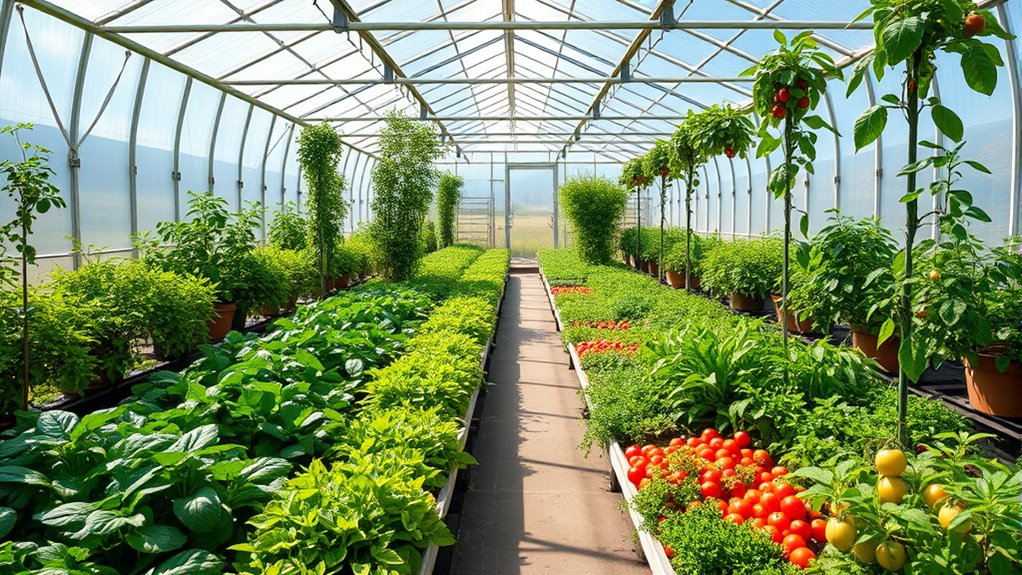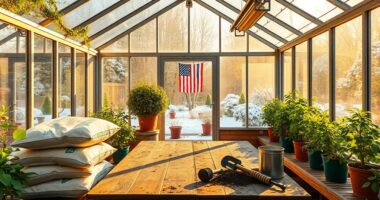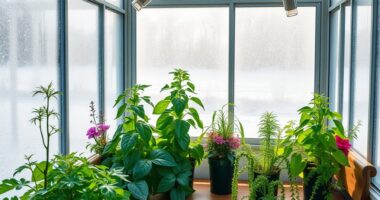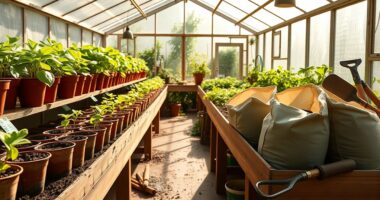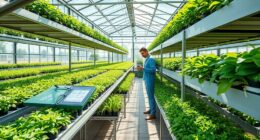To grow your greenhouse crops year-round, you need to manage temperatures effectively, ensuring a stable environment that suits each crop’s needs. Use automated ventilation, heating, and shading to maintain consistent conditions and prevent stress. Pick pest-resistant varieties and focus on cleanliness to reduce pests. By fine-tuning your climate controls, you can extend growing seasons and maximize yields. Keep these strategies in mind—you’ll discover more ways to optimize your greenhouse success as you explore further.
Key Takeaways
- Select crops suited for different temperature ranges to ensure continuous growth throughout the year.
- Implement automated climate control systems to maintain stable temperatures and prevent environmental fluctuations.
- Use shading, ventilation, and heating strategically to create optimal conditions for diverse crops.
- Plan crop rotations and stagger planting schedules to maximize harvest periods and reduce downtime.
- Incorporate pest-resistant varieties and proper environment management to minimize pest issues and crop losses year-round.
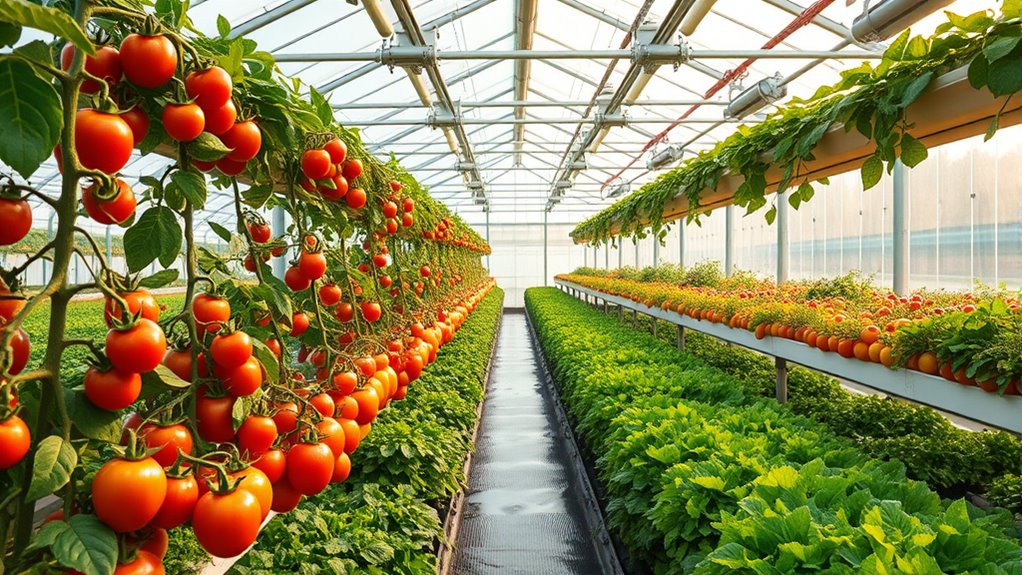
Planning your greenhouse crops carefully is essential to guarantee a successful and productive growing season. When you’re aiming for year-round harvests, understanding how to optimize temperature management and pest control becomes fundamental. These factors directly influence plant health, yield quality, and the overall efficiency of your greenhouse operation. By managing temperature effectively, you create an environment that supports steady growth and prevents stress that can weaken your crops. Proper ventilation, heating, and shading help maintain consistent temperatures, reducing risks of heat stress in summer and cold damage during winter. This stability allows you to extend growing seasons and grow a variety of crops without interruption.
Temperature management isn’t just about keeping things warm or cool; it’s about creating the right conditions for each crop’s specific needs. For instance, leafy greens thrive in cooler environments, while tomatoes and peppers prefer warmer temperatures. As you plan your crops, consider their ideal temperature ranges and adjust your greenhouse’s climate controls accordingly. Automated systems with sensors can help you monitor and fine-tune conditions, ensuring ideal growth environments at all times. This proactive approach minimizes fluctuations that could cause plant stress or reduce yields. Consistent temperature control also helps prevent pests, which tend to thrive in specific temperature ranges. By maintaining a stable environment, you’re less likely to attract infestations that can harm your crops and require costly pest control measures.
In addition, some pests are attracted to certain plant types, so choosing resistant varieties can further help reduce pest issues. Research shows that selecting resistant plant varieties not only decreases pest infestations but also enhances overall crop resilience. When planning your crops, select varieties that are resistant to common pests and diseases in your region. This step reduces the need for aggressive pest control, which can sometimes disturb your carefully maintained environment. Additionally, maintaining cleanliness and proper ventilation discourages pests and pathogens from settling in your greenhouse. When you combine vigilant pest control with your temperature management efforts, you create a hostile environment for pests while providing your crops with the ideal growing conditions. This synergy enhances plant health, reduces crop losses, and minimizes the use of chemical interventions.
Frequently Asked Questions
How Do I Manage Pests Year-Round in a Greenhouse?
To manage pests year-round in your greenhouse, prioritize pest prevention by maintaining cleanliness and monitoring conditions regularly. Practice pest identification to catch issues early, using traps or visual checks. Implement integrated pest management strategies, like introducing beneficial insects and rotating crops, to keep pests in check. Consistent vigilance and proactive measures help you prevent infestations, ensuring healthy, thriving plants all year long.
What Are the Best Lighting Options for Winter Growth?
Brighten your winter with the best lighting options by choosing artificial lighting that supports your plants’ growth. Focus on lights that offer a full light spectrum, mimicking natural sunlight and encouraging healthy development. LED grow lights are popular because they’re energy-efficient and customizable. By balancing brightness and spectrum, you’ll provide plants the perfect photonic platform for thriving through winter’s darkness, ensuring continuous, healthy harvests all season long.
How Can I Optimize Energy Use in My Greenhouse?
To maximize energy use in your greenhouse, focus on solar enhancement by increasing sunlight exposure with strategic placement and reflective surfaces. Use insulation techniques like double glazing, sealing gaps, and adding thermal curtains to retain heat efficiently. These steps reduce energy consumption, lower costs, and create a stable environment for your crops. Combining solar enhancement with effective insulation ensures you use energy wisely while maintaining ideal growing conditions year-round.
What Are Common Crop Rotation Mistakes to Avoid?
You might worry about soil depletion, but avoiding crop rotation mistakes can help. Forgetting crop succession or planting the same crops repeatedly can lead to nutrient loss and pests. To prevent this, rotate crops thoughtfully, mixing root vegetables with leafy greens. This keeps soil healthy, reduces disease risk, and promotes continuous harvests. Don’t overlook crop rotation; it’s key to sustainable, productive greenhouse growing.
How Do I Scale up My Greenhouse Operations Efficiently?
To scale up your greenhouse efficiently, focus on optimizing your hydroponic systems for higher yields and better resource use. Plan crop succession carefully to ensure continuous harvests without overloading your setup. Invest in automation tools and monitor your environment closely to maintain ideal conditions. Gradually increase your planting area, and keep detailed records to identify what works best. This approach helps you expand smoothly while maintaining quality and productivity.
Conclusion
By carefully planning your greenhouse crops, you’ll find that continuous harvest becomes a natural rhythm, almost like a coincidence. As you stagger planting and optimize conditions, the yields flow seamlessly from one season to the next. With each successful cycle, you’ll notice how the right timing and thoughtful organization create a steady, reliable supply. Ultimately, your dedication transforms coincidence into consistent success, making year-round growing not just possible, but effortlessly integrated into your greenhouse routine.
